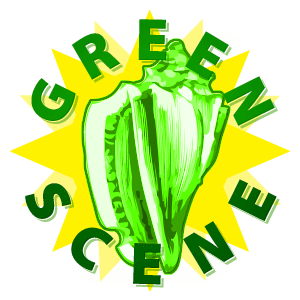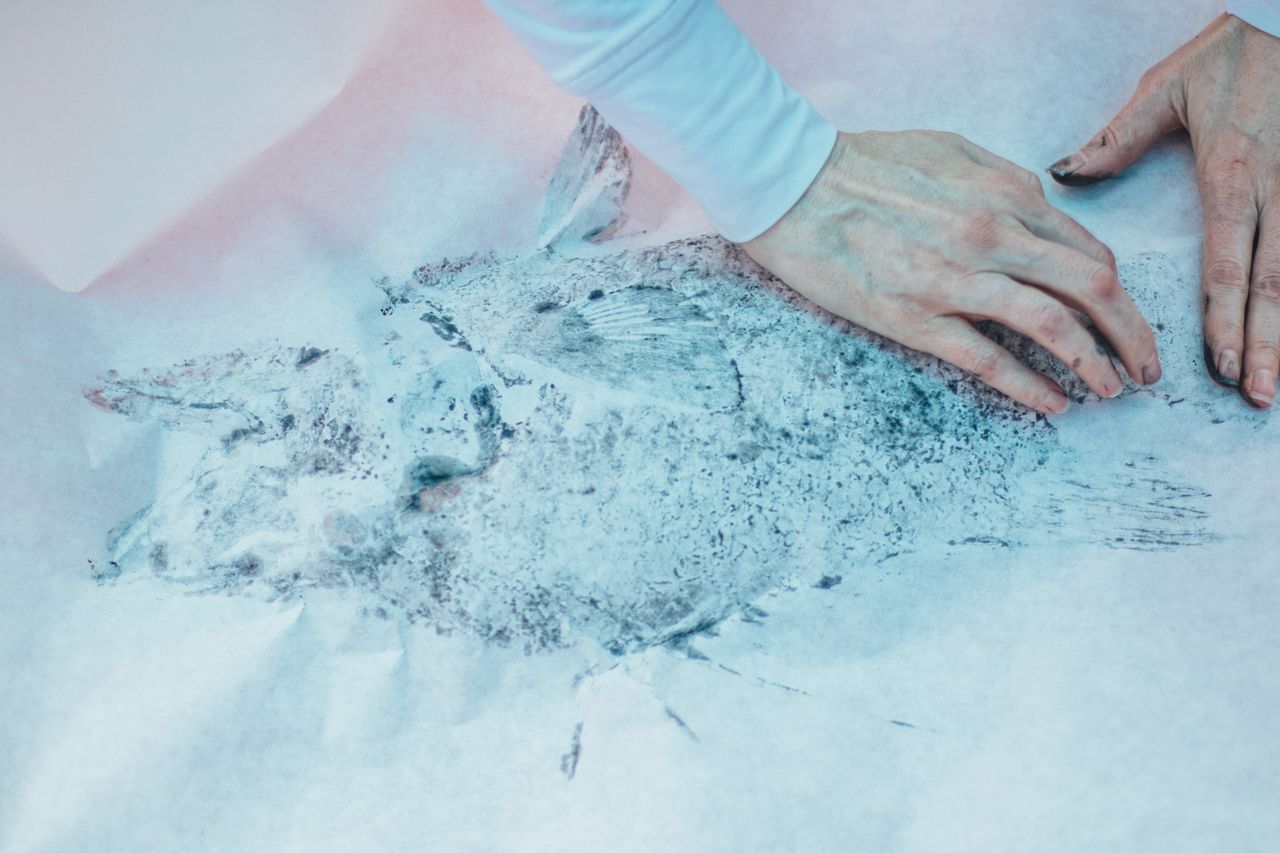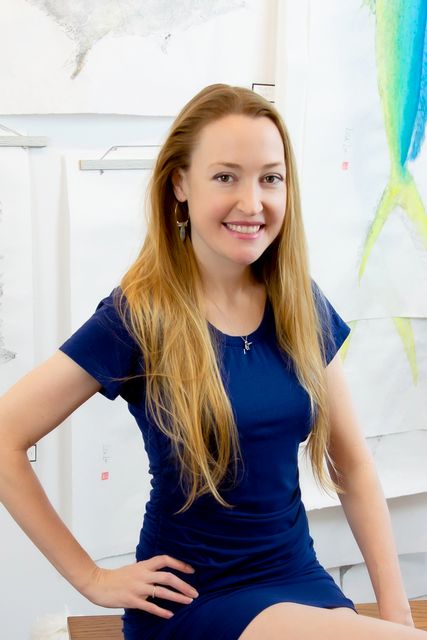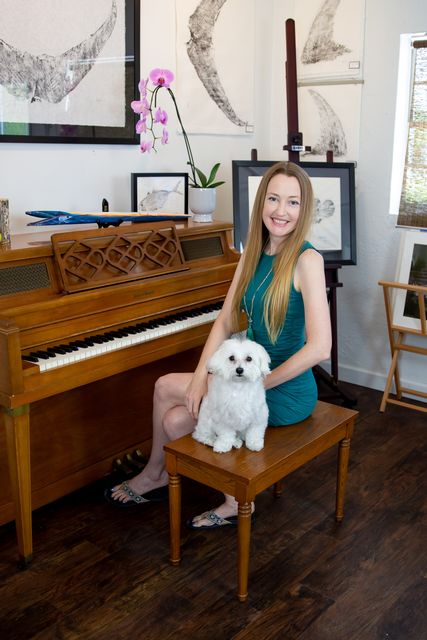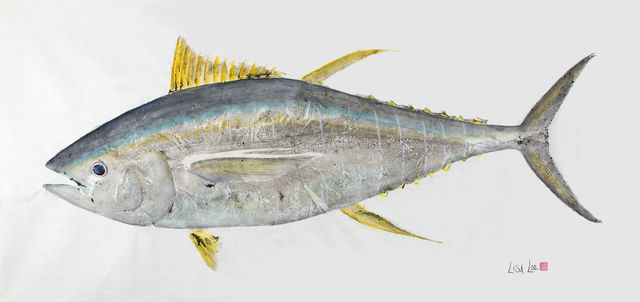Lisa Lee Herman: Steward of Keys Marine Life Through Art
Marine artist Lisa Lee Herman, owner of Gallery of the Arts Islamorada, is known throughout the Upper Keys for her gyotaku — the ancient Japanese art form for traditionally recording a catch.
Herman greets her gyotaku-seeking clients, and the prized fish they want to preserve, at the dock following their angling excursions. She uses nontoxic inks to painstakingly press the fish on kozo paper, or traditional Japanese mulberry paper, and later details colorful embellishments at her studio-gallery in Tavernier.
“I’ve always been intrigued by nature printing and marine art,” Herman said. “Each fish is anatomically different. The more you do gyotaku, the more you learn.”
She also expresses her creative talents in ways ranging from acrylic painting to teaching piano to 30 to 40 students during a typical school year.
Herman graduated from the University of Central Florida with a degree in psychology and music. She spent a semester at Scotland’s Edinburgh College studying color photography and abstract painting. She also studied and performed classical piano throughout Belgium and France.
After college, Herman moved to Chicago. She managed a downtown Blick Art Materials store until brutally cold winters motivated a move back to Florida. In late 2016 she opened her Florida Keys gallery.
Today, Herman’s work can also be seen at Islamorada restaurants Green Turtle Inn and Kaiyo Grill & Sushi. Through Oct. 3 her artistry is on display at the Florida Keys History & Discovery Center on the grounds of Islamorada’s Islander Resort.
Herman married Islamorada boat captain Jeff Tharp in a California vineyard in late August. The two live in historic Tavernier, and she plans to expand her gallery.
Keys Traveler: When did you first come to the Florida Keys and why?
Lisa Lee Herman: My family has been part of Islamorada since the early ‘60s, so since I was born. I was raised in Fort Lauderdale, and we visited our little spot in paradise nearly every weekend.
KT: What aspects of the Keys environment or way of life matter most to you?
LLH: I grew up fishing with my family, so I absolutely have to live near the water. What I love most about the Keys is the community. We’re all here because we share a common love for the ocean. The Keys’ environment is so unique — from the adorable Key deer, all the birds, flowers, insects, all alongside stunning coral reefs.
KT: Who or what inspired you to become passionate about respecting and protecting the Keys’ natural world?
LLH: My dad always showed us the coolest reefs to snorkel and the best spots to fish. I learned quickly how to respect the ocean and its creatures. Being able to handle fish, and release them, had me hook, line and sinker!
KT: How does that passion influence your work or profession?
LLH: My passion for the ocean and its influence on my art are 1000% connected. My art is produced mainly from species we get to then enjoy at the dinner table. Celebrating your catch with friends and family is so wonderful. Keeping a piece of art made from that fish is really special.
KT: What are some of the ways, personally or through your work, that you connect with and/or help protect the local environment and unique lifestyle?
LLH: I’ve always been a friend to all critters on land or at sea. I feel most called to protect and spread the love and knowledge of our increasingly fragile oceans. I contribute time, art and donations to local causes. I bring a small bag every time I walk my dog and try to pick up any little pieces of plastics or trash. I know it’s cliché but it’s so true: if we all do a little, we can do a lot.
KT: What keeps you energized, challenged and focused on your path?
LLH: The love and support from my family, my husband Jeff, the community and charter boat captains. Gyotaku, a challenging and ever-changing form of art, is never boring! Each species of fish is completely different from the next.
KT: What message do you want your actions and example to communicate to people you encounter?
LLH: My goal is to capture the beauty and uniqueness of each fish onto paper for all to enjoy. That translates to conservation: only take what you need. It breaks my heart to see people limit out, day after day after day, just for the sport of it. Everything in the ocean is connected to us. I want our next generations to see that.
KT: What’s your favorite natural or eco-friendly activity in the Keys?
LLH: Paddleboarding! It’s such a fun and peaceful way to get up close and personal with our natural world without any disturbances.
KT: What do you hope your positive environmental actions will accomplish?
LLH: To spread my knowledge and appreciation for this style of art and its origins and how important our oceans are to each of us. Looking at the fishes preserved in this unique way hopefully strikes a chord in us all to find joy and respect for all species.
Herman's background includes a degree in psychology and music, studies of color photography and abstract painting.
Herman greets her gyotaku-seeking clients, and the prized fish they want to preserve, at the dock following their angling excursions.
Lisa also expresses her creative talents in ways ranging from acrylic painting to teaching piano to 30 to 40 students during a typical school year.
Yellowfin tuna. Herman said celebrating your catch with friends and family is wonderful, and keeping a piece of art made from that fish is really special.

